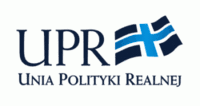Real Politics Union
The Real Politics Union (Polish: Unia Polityki Realnej, UPR) is a national conservative and economically liberal political party in Poland. In the past it was right-libertarian and classical liberal.
Real Politics Union Unia Polityki Realnej | |
|---|---|
 | |
| President | Bartosz Józwiak |
| Founded | 14 November 1987 (as a society) 6 December 1990 (as a party) |
| Headquarters | ul. Złota 7/18, 00-019 Warsaw |
| Ideology | Current: National liberalism National conservatism Economic liberalism Right-wing populism Hard Euroscepticism[1] Historical: Libertarian conservatism[2] Classical liberalism[3] Right-libertarianism[3] Laissez-faire Hard Euroscepticism[1] |
| Political position | Right-wing[1] |
| National affiliation | National Movement (2012-2015) Kukiz'15 (2015-2019) |
| Colours | Black Azure White |
| Sejm | 0 / 460
|
| Senate | 0 / 100
|
| European Parliament | 0 / 51
|
| Regional assemblies | 0 / 552
|
| Party flag | |
 | |
| Website | |
| www | |
Ideology
The party's goals are to create a minimal state, restricted to basic functions such as:
- Assuring citizen's safety.
- Assuring required infrastructure to effective government operation.
- Primary and secondary education financed by the government.
- Minimum pension for retired people.
- Funding healthcare for seriously ill and bedridden people.
Popular support and funding
UPR was founded in 1987 as the classic liberal Real Politics Movement by Janusz Korwin-Mikke, who later became its long-term leader.
In the 1990s and 2000s UPR consistently had the support of 1–2% of voters in general elections, too low to receive public funding under Polish electoral law. As a consequence, it has faced prolonged financial difficulties since its inception. In the 1991 legislative election, the party won 3 seats.
UPR's candidates commenced their political campaign from its short-lived satellite party Janusz Korwin-Mikke's Platform ("Platforma Janusza Korwin-Mikke"). The PJKM also did not manage to cross the required 5% threshold in the 2005 parliamentary elections (it got only 1.57%).
In the parliamentary election in 2007, the UPR candidates campaigned in cooperation with the League of Polish Families but did not enter into a formal coalition. The list on which both the UPR and the League appeared saw the UPR get 1.5% votes. This was insufficient to get any of their candidates into the lower house ("Sejm") and therefore the UPR remains unable to obtain public funding.
In October 2009 Janusz Korwin-Mikke left the party and its another former chairman, Stanisław Michalkiewicz, resigned from his honorary membership. In the following years, party became more nationalist.
In the 2011 Stanisław Żółtek along with pro-Korwinist faction toke part in the foundation of Congress of the New Right, which was led by the former chairman of the UPR Janusz Korwin-Mikke.
In the 2012 UPR along with the All-Polish Youth and National Radical Camp formed far-right political alliance National Movement, which merged into the political party in the 2014.
UPR cooperated with National Movement in the European Parliament election in 2014, Polish local elections in 2014 and the presidential election in 2015. In the Polish parliamentary election in 2015, the whole National Movement stand for the Sejm from the lists of Kukiz'15.
In the end of 2015 UPR leader Bartosz Józwiak left National Movement which ended the partnership between these parties.
In the 2019 UPR left Kukiz'15, because it didn't want to join the coalition with Polish People's Party.
Leadership
- Janusz Korwin-Mikke (1990–1997)
- Stanisław Michalkiewicz (1997–1999)
- Janusz Korwin-Mikke (1999–2002)
- Stanisław Wojtera (2002–2005)
- Jacek Boroń (2005)
- Wojciech Popiela (2005–2008)
- Bolesław Witczak (2008–2011)
- Bartosz Józwiak (2011–)
Party symbol
A special colour variation of St George's Cross is used here as a traditional symbol of a struggle for principles. The colours of the flag represent: a struggle for allegiance (blue), virtue (white) and liberty (black).
See also
References
- Basista, Jakub (2005), Carlisle, Rodney P. (ed.), "Poland", The Encyclopedia of Politics: The Left and the Right, Sage, p. 819
- Tóka, Gábor (1997). Political Parties in East Central Europe. Consolidating the Third Wave Democracies: Themes and Perspectives. Johns Hopkins University Press. p. 127.
- Hloušek, Vít; Kopeček, Lubomír (2010), Origin, Ideology and Transformation of Political Parties: East-Central and Western Europe Compared, Ashgate, p. 115
External links
- Official website (in Polish)
- UPR Wiki (in Polish)
- thank YouTube one of a few TV spots showing UPR state policy (in Polish)
- UPR TV (in Polish)
- Organisation of Polish Monarchists